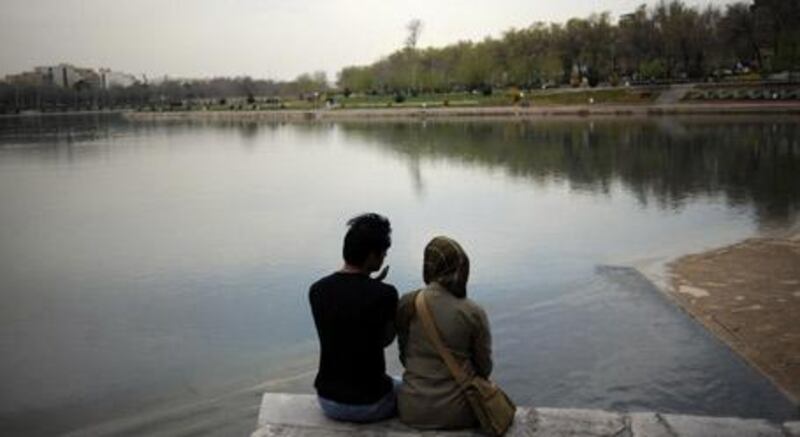Rayyan Al-Shawaf compares two accounts of love complicated by Iran's social strictures. Censoring an Iranian Love Story Shahriar Mandanipour (translated from Farsi by Sara Khalili) Knopf Dh90 Honeymoon in Tehran: Two Years of Love and Danger in Iran Azadeh Moaveni Random House Dh90 Even without the ongoing election-related turmoil, the Islamic Republic of Iran is never far from today's headlines, whether the subject is uranium enrichment or sponsorship of terrorist groups. Yet these issues tend to be strictly political in nature; social life and developments in the country often receive short shrift. That's why books such as Azadeh Moaveni's Honeymoon in Tehran, an account by Time's former Iran correspondent of how she met and married her husband in the midst of the country's political re-radicalisation, and Shahriar Mandanipour's Censoring an Iranian Love Story, an Iranian novelist's exploration of the obstacles faced by young Iranian paramours as well as those who would write about them, are so important. After all, politics aside, many Iranians find themselves struggling on a daily basis against their clerical regime's specifically social dictates, calculating how best to circumvent harsh and repressive measures restricting their movements, relationships and attire. Of course, there is much discussion of politics in Moaveni and Mandanipour's books, but more often than not it is in relation to the protagonists' lives. Reading them, one realises that in the Islamic Republic of Iran, a theocracy born out of a revolution in 1979, the notion that romantic love should be given free reign, and that it should form the basis of marriage, is a revolution that has yet to occur.
The American-born and raised Azadeh Moaveni is a Time magazine contributing writer who until recently lived and worked in Lebanon and Iran, the country from which her parents emigrated decades ago. While on an extended stay in the land of her origins in 2005, Moaveni meets and falls in love with Arash. Soon, she becomes pregnant, and this causes her much concern, for "in the Islamic Republic of Iran, one could not be unmarried and pregnant. That social category of individual simply did not exist."
Even after Arash proposes and Moaveni accepts, she must endure countless indignities, including obtaining her father's permission to marry. An exasperated Moaveni notes: "I had spent years reporting on women's inferior legal status in the Islamic Republic, and could repeat by rote the most egregious examples: their testimony as witnesses counted for only a third of a man's; their families were entitled to only half the compensation, or 'blood money', that the families of male victims received; their custody rights over children were partial at best. But somehow I had missed this particular instance of discrimination." Of course, once she obtains her father's consent and duly weds the man she loves, Moaveni becomes legally subordinate to her husband.
Shahriar Mandanipour is an Iranian novelist who was born and raised in Iran. His most recent novel - his first to be translated into English - features the postmodern artifice of textual commentary alongside the story, in this case a romance between Dara, the male protagonist, and Sara, the young woman with whom he is besotted. The commentary outlines the tricks Mandanipour must employ to get some version of that story approved by his censor.
As a veteran of his country's draconian censorship practices, Mandanipour has mastered a number of techniques for conveying meaning in an allusive manner. For example, he explains that due to the Islamic Republic's obsession with the headscarf, "if one day an Iranian writer decides to describe the black cascade of his Sara's hair, the best trick is that same defamiliarization envisioned by Russian formalists. The writer can, without mentioning the word 'hair', write: 'Rippling nightlike strands that flow from the living marble and that the black wind ushers toward the light...'"
When describing the even more controversial reality of a woman's body, Mandanipour notes that the classics of Persian poetry, most of whose authors were Sufis, come in handy: "[The Sufi poet] uses many words to liken his beloved's beauties to nature, fruits, and flowers; of course not directly, but by using familiar similes." Both Honeymoon in Tehran and Censoring an Iranian Love Story feature a sinister government official with a central role in the proceedings. In Moaveni's case, she doesn't even know his real name. "As my official government minder, Mr X was perhaps the most important person in my Iranian life. The regime charged him with maintaining a file of my conduct as a journalist, alerting me to the red lines of coverage (marking subjects as taboo or discouraged), and attempting to secure my 'co-operation'." In Censoring an Iranian Love Story, Mandanipour informs the reader of his own bête noire, a low-level but powerful government official who has earned comparisons to a character in Dostoevsky's Crime and Punishment. At the Ministry of Culture and Islamic Guidance "a man with the alias Porfiry Petrovich (yes, the detective in charge of solving Raskolnikov's murders) is responsible for carefully reading books, in particular novels and short story collections, and especially love stories" in order to decide what must be censored and what cannot be published at all.
Despite such similarities, it is instructive to note the differences in the love-related travails of fictional Sara and Dara, on one hand, and real-life Moaveni and Arash, on the other. For all her well-founded fears about being unmarried and pregnant in Iran, Moaveni experiences no trouble from the authorities. Those difficulties pertaining to her personal situation that she does encounter consist of little more than social awkwardness - sometimes of a decidedly amusing nature. When Shirin Ebadi, the Iranian Nobel Peace Prize laureate with whom Moaveni is collaborating on a book, calls her husband to arrange a lunch date, she refers to Arash as Moaveni's namzad because "traditional Iranians do not recognise the category of boyfriends, who are elevated in discourse to fiancés". And when Moaveni moves in with Arash, despite the fact that cohabitation of unmarried couples is illegal, she does not fear that anything will befall them. Meanwhile, Sara and Dara cannot spend any time alone together, let alone consummate their relationship. If together in public, they have to worry about being arrested by roving patrols of the Campaign Against Social Corruption. As a result, "[u]nconsciously, and unlike lovers throughout the world, they avoid strolling along quiet streets and beautiful tree-lined alleys. Walking down a crowded pavement, sheltered by pedestrians, lessens the danger of being seen and arrested."
The differences between the two couples' situations have much to do with their status. Moaveni, though of Iranian origin, is an American journalist reporting for a major news outlet. Her morality is of little concern to the Islamic regime; what matters to them is her depiction of Iran in her articles. Somewhat paradoxically, Arash, an Iranian-German with no special standing in his country, might have been punished for "fornicating" with his partner had she been a similarly nondescript person. The other factor working in their favour is that Moaveni moves in with Arash during a relatively relaxed political period. Mahmoud Ahmadinejad has just won the 2005 presidential election, but is being careful not to frighten those many Iranians who have grown accustomed to the greater social freedoms they were accorded under his predecessor, Mohammad Khatami; there are few indications that a renewed round of repression will soon be set in motion. By the time that bout of repression begins - in the second half of 2006 - Moaveni and Arash have got married. Censoring an Iranian Love Story, on the other hand, begins in 2006 - in the author's words, "one hundred and one years" after "the first revolution for democracy triumphed in Iran". Ahmadinejad was consolidating his power and, toward the end of that year, unleashed his campaign to return Iranians to the values of the 1979 Islamic revolution.
In large part because it distinguishes between a few of the postrevolutionary phases in Iran, during which time social regulations governing everything from the mingling of the sexes to women's attire were not uniformly enforced, Honeymoon in Tehran emerges as generally more historically nuanced than Censoring an Iranian Love Story, which does not delve into such matters except to point out that the period immediately following the revolution proved to be the most oppressive. At times, however, Moaveni's laudable quest to understand and elucidate Iran's complexities, especially as against the western media's common depiction of the country as a monolith of mullahs, has led her to naive conclusions. To her credit, she bravely recounts a few of these for the reader, including a remarkably optimistic would-be epiphany during the initial, largely innocuous phase following Ahmadinejad's election in 2005: "I felt more certain than ever that the country was mending." Mandanipour, at least in Censoring an Iranian Love Story, is afflicted by no such temptation to allow desire to obscure reality.
Moaveni's prose can be described as journalistic in the finest sense, meaning eloquent in style and edifying in content; Mandanipour's writing cannot be characterised quite so simply. When addressing the reader, he often adopts a conversational tone; when crafting passages in the tale that he hopes will escape the censor's wrath, he employs a straightforward storytelling method in the third-person narrative voice. Thanks to Sara Khalili, who translated Censoring an Iranian Love Story from the Persian, both styles emerge clear and distinct. And in both cases, Mandanipour periodically treats readers to impressive figurative language, as in a description of "[a] man whose large belly is sticking out from his pyjamas, with the long hair around his navel swept in one direction like algae in street gutters".
Crucially, both Moaveni and Mandanipour are writing for a western audience. This may not be particularly surprising in Moaveni's case, as she has been doing just that for her entire career. But for Mandanipour, this signifies a major reorientation, a conscious (though probably reluctant) decision to direct his attention at least partially westward. While it may be considered ironic that Censoring an Iranian Love Story has not been published in Iran, Mandanipour was prescient enough to foresee such an outcome. Though written in Farsi, the novel clearly targets westerners, what with Mandanipour's often painstaking explanations of Iranian social mores, political creeds and literary styles.
That both books, despite their differences, address the non-Iranian reader on the subject of love in the country's social and political vortex makes it rewarding to read them in tandem - all the more so because the authors focus on separate stages of a romantic relationship. Mandanipour has his unmarried protagonists carefully navigate streets patrolled by the Campaign Against Social Corruption, and anxiously ponder co-ordinating private assignations. Meanwhile, married and pregnant Moaveni must figure out how to bypass internet censorship that has blocked all websites having anything to do with women and pregnancy; later, when she nears her due date, it comes time to grapple with the outrageous law that prohibits her husband from being in the delivery room to witness the birth of their child.
Tellingly, both Moaveni and Mandanipour have apparently decided that there is no future for them in Iran so long as the country remains in the grip of the mullahs. Moaveni resignedly concludes as much toward the end of her book, despite having undertaken two major attempts in recent years to make a home for herself in her country of origin. Mandanipour's situation is even more troubling. For years, he strove diligently to work within the stultifying confines of the Islamic Republic; even the fact that censorship rendered him unable to publish his fiction from 1992 until 1997 did not lead him to give up. Eventually, however, it all became too much to bear, and in 2006 he moved to the US, where he is currently a professor at Harvard University. Perhaps when Sara and Dara finally have the chance to pursue their relationship freely and openly, their creator will return to Iran, as will Azadeh Moaveni and countless other Iranian writers and artists from Dubai to California.
Rayyan Al-Shawaf is a writer and book critic based in Beirut.











